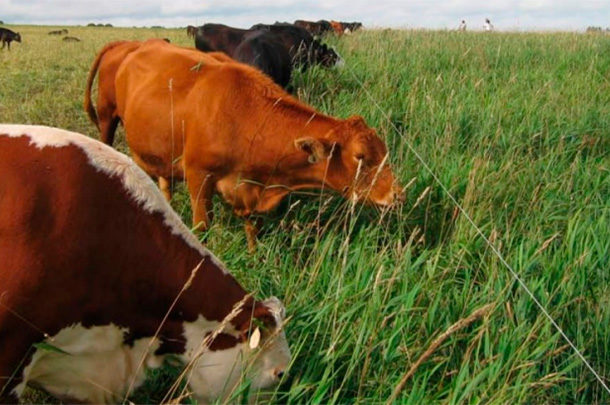Since the backbone of any rotational grazing system is flexibility, it is important to have a highly-movable temporary fence and some understanding of its proper use.
Wires
There are two basic types of temporary electric fence wires on the market: polywire and polytape. Both are made up of fine metal filaments braided with strands of polyethylene or polypropylene fibers. The metal carries the shock, and the plastic gives the wire strength and visibility.
If you are using polywire for short distances to subdivide a pasture, six-strand polywire is sufficient to do the job. If you want to run polywire for a long distance or for a fence that may become overgrown with weeds and grass, buy a wire that carries more of a shock.
Polytapes are more visible than polywires, especially the color white. If you are getting poor animal control with polywire, or if visibility is important (such as with horses), you might consider switching to polytape. Having better animal control will offset the additional cost of polytape.
In addition, if you plan to move the fence for any reason, such as changing the paddock size, a reel is essential. Electric fence reels are made from weather resistant plastic and will hold one to two spools of polywire or polytape.
Posts
Plastic posts are the most convenient to use because they have built-in treads to step the posts into the ground. Ring-top and pre-molded loops provide plenty of flexibility for a variety of wire spacings. Fiberglass rods are better suited for situations where you will not be moving the fence very often. They are more expensive than plastic posts but can last up to 20 years. They are easily driven into the ground with a hammer, but they do take a little longer to install than plastic posts.
Metal T-posts are stronger and last longer than other temporary posts, but they cost more and require more labor to install and remove when changing paddock size. However, since they are not flexible like other posts, they do work well as corner posts or when making sharp turns in the fence line.
The amount of shock animals feel depends on the voltage. It takes a minimum of 5,000 volts to produce a shock sufficient to control cattle and horses. Commonly, the best fence energizers will deliver 6,000 to 8,000 volts. If your fields are near a mains 120-volt power source, your best choice is an AC-powered energizer. AC energizers usually have higher joule ratings and require no battery maintenance. If the fence you plan to electrify is not near a 120-volt power source, you have no choice but to use a battery-operated (DC) or solar energizer. DC energizers do an excellent job of confining animals and are very dependable. Deep-cycle batteries are best suited for battery-operated energizers.
Paddock Layout
Being able to get livestock to the pasture is as important as producing forage in the pasture. The fine wires used in polywires and polytapes have a high resistance to current flow. Even large, powerful energizers cannot pump enough energy through the wires for very long distances. For this reason, the maximum effective distance you can charge a 6-strand polywire is about half a mile from the energizer. You can power up to a mile of polywire by placing the energizer in the middle of the fence and going half a mile in each direction. It is best to run a single, high-tensile wire along the perimeter of the pasture and run the temporary wire off this feeder wire when subdividing large pastures. Generally, only one strand of polywire is needed for cattle and horses. Posts can be up to 50 feet apart.
Grounding
Most electric fence problems are the result of poor grounding. For an animal to receive a shock, it must complete a circuit. With temporary electric fences, this circuit consists of one “hot” wire and a soil ground return. The energizer generates a high-voltage pulse. From there, it travels through the wire, through the animal, to the soil, back to a ground rod and then up the ground rod back to the energizer. The shock felt by an animal from a poorly grounded system, in most cases, will be inadequate to keep the animal from walking through the fence. The first step in establishing a good grounding system is to install a minimum of three 6-foot-long galvanized ground rods to properly ground electric fence energizers. More powerful units may require up to eight or 10 rods.
Rods should be driven 5 ½ feet into the soil and spaced a minimum of 10 feet apart. Locate ground rods so they are highly visible, near permanent moisture and do not interfere with mowing or cultivation.
Connect the energizer to the ground rods with an insulated cable or 12 1/2-gauge galvanized wire and ground rod clamp. Use one continuous wire and firmly attach the wire to each rod with ground rod clamps. You can test the adequacy of your grounding system using a KV fence voltage meter. If the voltmeter reads less than 3,000 volts, then you may have the following problems:
- Not enough ground rods (this is the most common problem)
- Ground rods are too close together
- Poor connections between ground rods
- A short on the fence
For more information on rotational grazing or electric fencing, you can contact Ray Williams.









